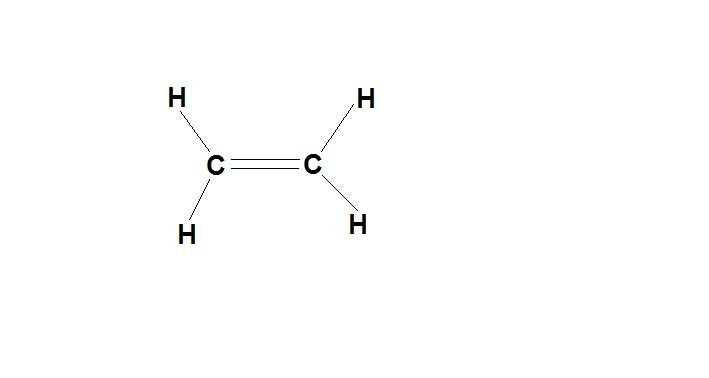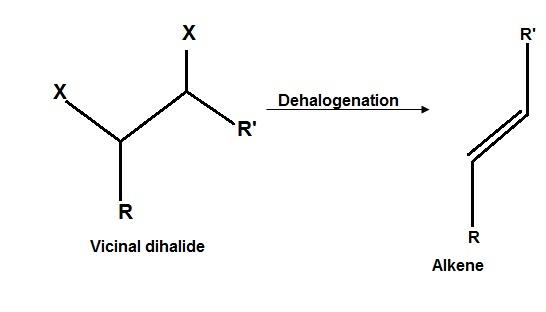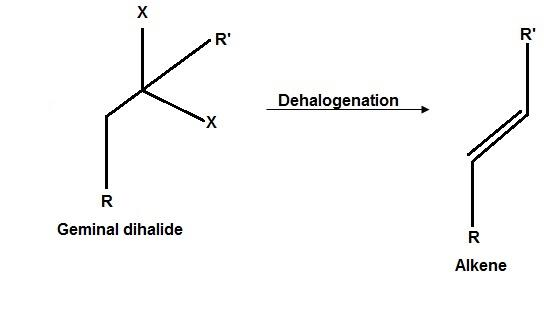
Which dihalide is taken during the preparation of alkenes from dehalogenation reaction?
A.Geminal dihalide
B.Vicinal dihalide
C.Isolated dihalide
D.Any dihalide
Answer
474.3k+ views
Hint: The reaction which involves the cleavage of carbon bond during the formation of product is known as dehalogenation reaction. This reaction can be reductive dehalogenation and hydro dehalogenation.
Complete step by step answer:
From the question, we have already got the idea that we have to prepare alkenes from dihalide with the help of dehalogenation reaction.
So, first of all we need to know what a dehalogenation reaction is.
The dehalogenation reaction can be defined as the reaction which includes the cleavage of carbon bond for the manufacturing of the product. This type of reaction can be classified into two:
Reductive dehalogenation
Hydro dehalogenation
Now, we have to know about alkenes.
Alkene can be defined as the hydrocarbon in chemistry in which there is double in carbon – carbon. They are colourless apolar compounds. They can be similar to alkanes but more reactive than alkanes. The general molecular formula for alkenes is ${C_n}{H_{2n}}$, where $n$ is always more than zero. For example, when $n$ is $2$ then, the molecular formula will be ${C_2}{H_4}$.
It can look like –

For the preparation of alkenes by using the dihalides with the help of dehalogenation reaction we use geminal dihalide and vicinal dihalide.
So, the reaction of preparation of alkene from vicinal dihalide is shown below –

Next the reaction of preparation of alkene from geminal dihalide is shown below –

Hence, the correct option of this question is (A) and (B) both .
Note:
The alkenes can be prepared from other process which are:
By partial reduction of alkynes
From alkyl halides
From monohydric alcohols or alkanols
From sodium or potassium salts
Complete step by step answer:
From the question, we have already got the idea that we have to prepare alkenes from dihalide with the help of dehalogenation reaction.
So, first of all we need to know what a dehalogenation reaction is.
The dehalogenation reaction can be defined as the reaction which includes the cleavage of carbon bond for the manufacturing of the product. This type of reaction can be classified into two:
Reductive dehalogenation
Hydro dehalogenation
Now, we have to know about alkenes.
Alkene can be defined as the hydrocarbon in chemistry in which there is double in carbon – carbon. They are colourless apolar compounds. They can be similar to alkanes but more reactive than alkanes. The general molecular formula for alkenes is ${C_n}{H_{2n}}$, where $n$ is always more than zero. For example, when $n$ is $2$ then, the molecular formula will be ${C_2}{H_4}$.
It can look like –

For the preparation of alkenes by using the dihalides with the help of dehalogenation reaction we use geminal dihalide and vicinal dihalide.
So, the reaction of preparation of alkene from vicinal dihalide is shown below –

Next the reaction of preparation of alkene from geminal dihalide is shown below –

Hence, the correct option of this question is (A) and (B) both .
Note:
The alkenes can be prepared from other process which are:
By partial reduction of alkynes
From alkyl halides
From monohydric alcohols or alkanols
From sodium or potassium salts
Recently Updated Pages
Master Class 11 Accountancy: Engaging Questions & Answers for Success

Master Class 12 Economics: Engaging Questions & Answers for Success

Master Class 12 Maths: Engaging Questions & Answers for Success

Master Class 12 Biology: Engaging Questions & Answers for Success

Master Class 12 Physics: Engaging Questions & Answers for Success

Master Class 12 Business Studies: Engaging Questions & Answers for Success

Trending doubts
Which are the Top 10 Largest Countries of the World?

Differentiate between homogeneous and heterogeneous class 12 chemistry CBSE

What is a transformer Explain the principle construction class 12 physics CBSE

Draw a labelled sketch of the human eye class 12 physics CBSE

What are the major means of transport Explain each class 12 social science CBSE

What is the Full Form of PVC, PET, HDPE, LDPE, PP and PS ?




